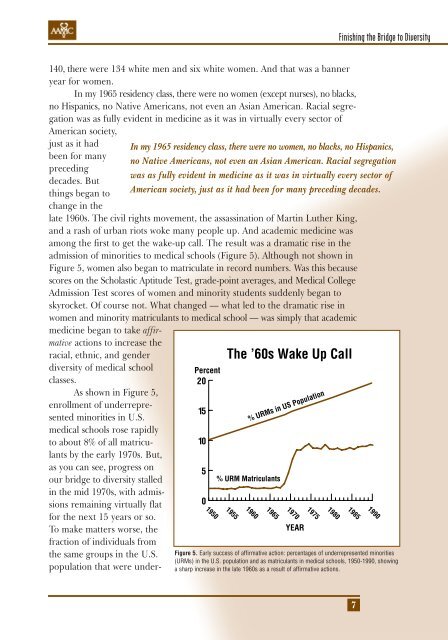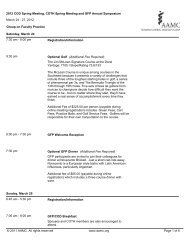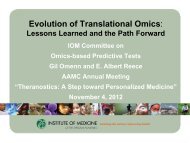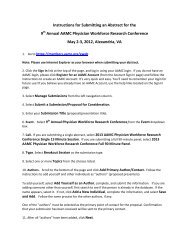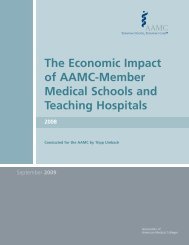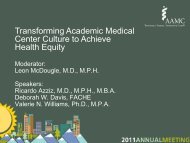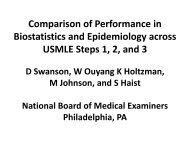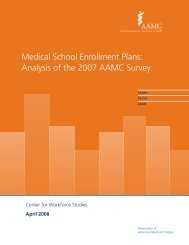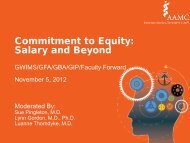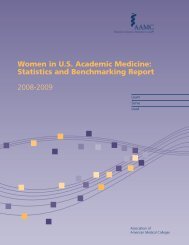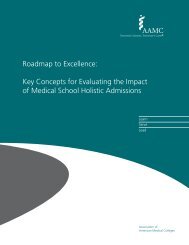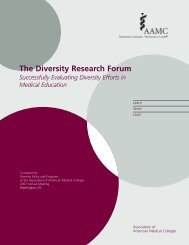Finishing the Bridge to Diversity - Member Profile - AAMC
Finishing the Bridge to Diversity - Member Profile - AAMC
Finishing the Bridge to Diversity - Member Profile - AAMC
You also want an ePaper? Increase the reach of your titles
YUMPU automatically turns print PDFs into web optimized ePapers that Google loves.
<strong>Finishing</strong> <strong>the</strong> <strong>Bridge</strong> <strong>to</strong> <strong>Diversity</strong><br />
140, <strong>the</strong>re were 134 white men and six white women. And that was a banner<br />
year for women.<br />
In my 1965 residency class, <strong>the</strong>re were no women (except nurses), no blacks,<br />
no Hispanics, no Native Americans, not even an Asian American. Racial segregation<br />
was as fully evident in medicine as it was in virtually every sec<strong>to</strong>r of<br />
American society,<br />
just as it had In my 1965 residency class, <strong>the</strong>re were no women, no blacks, no Hispanics,<br />
been for many<br />
no Native Americans, not even an Asian American. Racial segregation<br />
preceding<br />
was as fully evident in medicine as it was in virtually every sec<strong>to</strong>r of<br />
decades. But<br />
things began <strong>to</strong><br />
American society, just as it had been for many preceding decades.<br />
change in <strong>the</strong><br />
late 1960s. The civil rights movement, <strong>the</strong> assassination of Martin Lu<strong>the</strong>r King,<br />
and a rash of urban riots woke many people up. And academic medicine was<br />
among <strong>the</strong> first <strong>to</strong> get <strong>the</strong> wake-up call. The result was a dramatic rise in <strong>the</strong><br />
admission of minorities <strong>to</strong> medical schools (Figure 5). Although not shown in<br />
Figure 5, women also began <strong>to</strong> matriculate in record numbers. Was this because<br />
scores on <strong>the</strong> Scholastic Aptitude Test, grade-point averages, and Medical College<br />
Admission Test scores of women and minority students suddenly began <strong>to</strong><br />
skyrocket. Of course not. What changed — what led <strong>to</strong> <strong>the</strong> dramatic rise in<br />
women and minority matriculants <strong>to</strong> medical school — was simply that academic<br />
medicine began <strong>to</strong> take affirmative<br />
actions <strong>to</strong> increase <strong>the</strong><br />
racial, ethnic, and gender<br />
diversity of medical school<br />
classes.<br />
As shown in Figure 5,<br />
enrollment of underrepresented<br />
minorities in U.S.<br />
medical schools rose rapidly<br />
<strong>to</strong> about 8% of all matriculants<br />
by <strong>the</strong> early 1970s. But,<br />
as you can see, progress on<br />
our bridge <strong>to</strong> diversity stalled<br />
in <strong>the</strong> mid 1970s, with admissions<br />
remaining virtually flat<br />
for <strong>the</strong> next 15 years or so.<br />
To make matters worse, <strong>the</strong><br />
fraction of individuals from<br />
<strong>the</strong> same groups in <strong>the</strong> U.S.<br />
population that were under-<br />
Percent<br />
20<br />
15<br />
10<br />
5<br />
0<br />
1950<br />
The ’60s Wake Up Call<br />
% URM Matriculants<br />
1955<br />
1960<br />
% URMs in US Population<br />
1965<br />
1970<br />
YEAR<br />
Figure 5. Early success of affirmative action: percentages of underrepresented minorities<br />
(URMs) in <strong>the</strong> U.S. population and as matriculants in medical schools, 1950-1990, showing<br />
a sharp increase in <strong>the</strong> late 1960s as a result of affirmative actions.<br />
1975<br />
1980<br />
1985<br />
1990<br />
7


